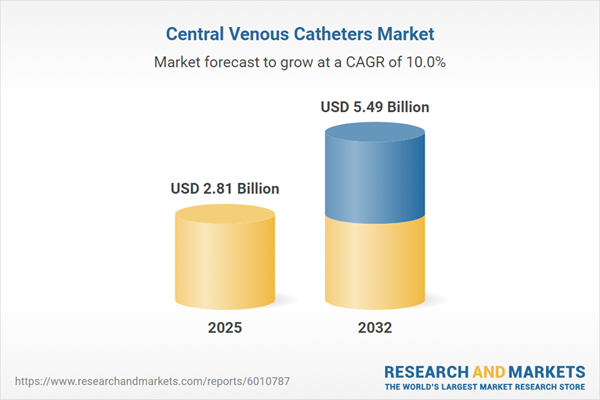Speak directly to the analyst to clarify any post sales queries you may have.
The central venous catheter market presents senior executives with shifting priorities amid evolving technology, regulatory updates, and changing care models. Staying ahead requires a proactive, risk-aware approach to procurement, compliance, and patient safety.
Market Snapshot: Central Venous Catheter Market Overview
In 2024, the central venous catheter market reached USD 2.56 billion and is projected to grow to USD 2.81 billion by 2025. The sector’s momentum is shaped by growing adoption of advanced vascular access solutions, focused efforts on infection control, and reinforced patient safety protocols in health systems worldwide. Increased attention to evolving reimbursement frameworks and variable regional requirements is transforming organizational procurement processes. Vendors who provide both innovative and standardized options better address increasingly stringent regulatory environments and diverse care needs. As procurement teams refine vendor rationalization, strategic investments aligned to local and international expectations are becoming more prevalent across the supply chain.
Scope & Segmentation in the Central Venous Catheter Market
This analysis delivers senior decision-makers granular insights for risk mitigation, procurement, and regulatory compliance across the central venous catheter landscape. Comprehensive segmentation enables organizations to tailor strategies for both global and local markets.
- Product Types: Portfolio includes implantable ports, non-tunneled catheters, tunneled catheters, and peripherally inserted central catheters (PICCs), with options such as Broviac, Groshong, and Hickman tips to support diverse clinical requirements.
- Key Applications: Devices enable hemodialysis, infusion therapy, parenteral nutrition, and continuous monitoring within acute care hospitals, ambulatory facilities, specialty clinics, and in home-care situations, supporting various healthcare delivery models.
- End Users: Hospitals, ambulatory surgical centers, dialysis centers, specialty practices, and home healthcare providers demand solutions matched to unique patient profiles and operational needs.
- Lumen Options: Single through quadruple-lumen designs enhance workflow flexibility for a wide range of interventions, addressing both routine and advanced clinical use cases.
- Material Choices: Polyurethane and silicone are primary materials, balancing longevity with safety across procedure intensity and therapy duration.
- Tip Configurations: Devices with standard or power-injectable tips prioritize operator safety and efficiency, adapting to multiple procedural demands.
- Regional Markets: Distinct procurement dynamics exist in the Americas, Europe, Middle East, Africa, and Asia-Pacific, each featuring specific compliance requirements and care preferences shaping product development and vendor relationships.
- Company Coverage: Leading manufacturers—Becton, Dickinson and Company; Teleflex Incorporated; Smiths Group plc; B. Braun Melsungen AG; Cardinal Health; ICU Medical; Medtronic; Getinge; AngioDynamics; and Merit Medical Systems—address stringent clinical and regulatory demands through diversified product portfolios.
Key Takeaways for Senior Stakeholders
- Infection prevention and smart-enabled central venous catheter devices are influencing purchasing strategies, reinforcing both patient safety and operational reliability.
- Digitally integrated, infection-resistant devices are moving from niche to cornerstone status in sourcing plans, particularly in high-acuity and critical care environments.
- Regulatory changes at global and regional levels demand robust post-market surveillance and strengthened documentation practices, reducing risk while smoothing market entry.
- Procurement models increasingly focus on device lifecycle management, ongoing maintenance, and overall outcomes, shifting emphasis away from upfront price alone.
- Adaptive supply chains and solutions tailored to regional health system needs provide organizations with flexibility to meet shifting regulations and care protocols.
- Advanced analytics tools are being leveraged to optimize purchasing forecasts, track compliance, and ensure supply stability during regulatory transitions.
Tariff Impact: Navigating New Procurement Realities
New tariff regulations in the United States are prompting healthcare providers to enhance domestic manufacturing and strengthen strategic supplier partnerships. Senior leaders are relying on data-driven procurement and flexible agreements to address cost pressures and bolster supply chain resilience in a complex sourcing climate.
Methodology & Data Sources
This report synthesizes direct engagements with clinical and procurement leaders, rigorous market trend analyses, and detailed regulatory scenario planning. Data reliability and strategic accuracy are achieved through triangulation and SWOT evaluations designed specifically for executive-level decision-making in the central venous catheter market.
Why This Report Matters: Strategic Value for Decision-Makers
- Equips executives with actionable frameworks to stay ahead of regulatory, technological, and market shifts in vascular access devices, supporting proactive and confident strategy development.
- Streamlines sourcing, compliance, and risk management efforts with proven industry insights to help organizations align operations amid market evolution.
- Supports organizations in achieving synergy between clinical imperatives and long-term business objectives, directly contributing to stable and efficient operations.
Conclusion
This comprehensive market analysis provides the strategic guidance and evidence-based tools leaders need to confidently manage efficiency, compliance, and quality standards within the evolving central venous catheter sector.
Additional Product Information:
- Purchase of this report includes 1 year online access with quarterly updates.
- This report can be updated on request. Please contact our Customer Experience team using the Ask a Question widget on our website.
Table of Contents
3. Executive Summary
4. Market Overview
7. Cumulative Impact of Artificial Intelligence 2025
Companies Mentioned
The companies profiled in this Central Venous Catheters market report include:- Becton, Dickinson and Company
- Teleflex Incorporated
- Smiths Group PLC
- B. Braun Melsungen AG
- Cardinal Health, Inc.
- ICU Medical, Inc.
- Medtronic PLC
- Getinge AB
- AngioDynamics, Inc.
- Merit Medical Systems, Inc.
Table Information
| Report Attribute | Details |
|---|---|
| No. of Pages | 197 |
| Published | November 2025 |
| Forecast Period | 2025 - 2032 |
| Estimated Market Value ( USD | $ 2.81 Billion |
| Forecasted Market Value ( USD | $ 5.49 Billion |
| Compound Annual Growth Rate | 10.0% |
| Regions Covered | Global |
| No. of Companies Mentioned | 11 |









